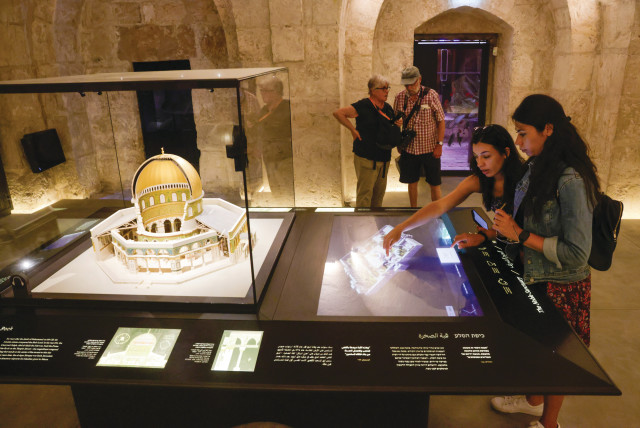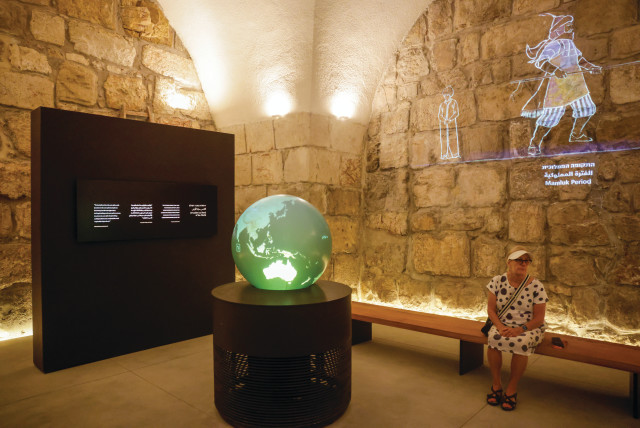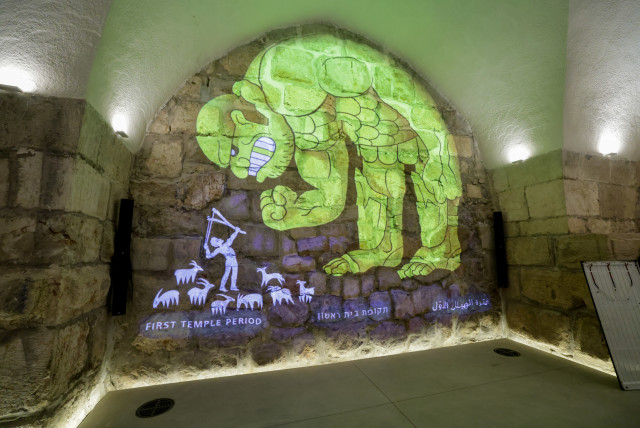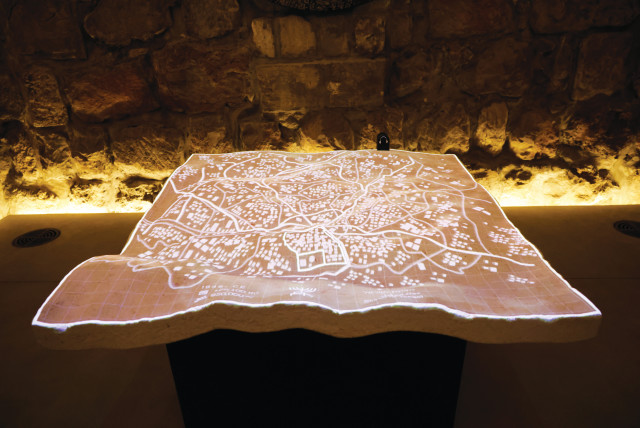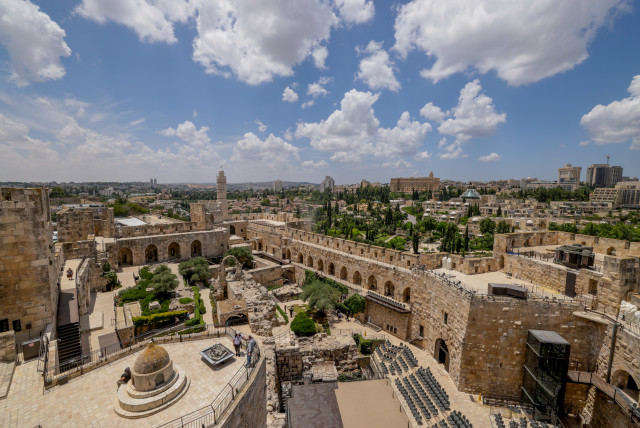Jerusalem's Tower of David: Using innovation to cover 4,000-year history

The Tower of David Museum has created an interactive experience that is a dream come true for history enthusiasts, teaching the history of Jerusalem to a new generation.
At the center of Israel’s capital lies the historic heart of the country: the Old City of Jerusalem. Jerusalem is a city that has stood the test of time, being a central city to three major religious faiths and numerous empires. But while the spiritual heart of the city may lie on the Temple Mount or the Church of the Holy Sepulchre, the seat of temporal power stood at the citadel around the Tower of David.
And as the city of Jerusalem continues to evolve with the times, so too must the Tower of David evolve with it.
The Tower of David Museum, which has for years told the story of Jerusalem’s history from the biblical era until the modern day, has undergone painstaking renovations over the past three years.
It’s a renovation that has cost $50 million, with funds raised mostly by the Clore Israel Foundation. But thanks to the time and hard work by the many organizations partnering together for this common goal, this $50m. vision has been brought to life. And the result is a museum unlike any other – one that is a dream come true for any history buff, theologian or passionate Zionist.
Ahead of its opening on June 1, the Magazine was given an early look at the renovated facility, embarking on a lengthy four-hour tour of the museum.
The detailed and thorough renovation was meant to help bring the museum into the modern age, to tell the history of Jerusalem in a new and engaging way that would be relevant for new generations without skipping over the details that make this museum so special. After all, the Tower of David has quite literally seen it all.
“Since ancient times, everyone knew that if you control the citadel, you control Jerusalem,” explained Amit Re’em, the Antiquities Authority’s Jerusalem regional archaeologist.
How fitting, then, that this fortress that controlled Jerusalem now holds the best way of learning about its history.
That was actually the idea behind the renovation itself.
Originally, visitors to the Tower of David Museum would have to go through the Old City before entering the museum by the Jaffa Gate. However, the renovations made a new entrance, a pavilion outside the walls, so visitors could enter the museum without having to go through the Old City.
In other words, by entering the Tower of David and going through it, visitors will learn about all of Jerusalem’s history and the many cultures that called it home, as well as the many religions it has helped shape. After that, they exit the citadel and enter the final exhibit: the Old City itself.
Construction is still well underway for some of the bigger plans the museum has in store. The huge gap underneath the road near the Old City, once a Byzantine-era bathhouse, will be made into a full-fledged education center and a tunnel connecting the Tower of David to Teddy Park.
But all that is phase two. Right now, the museum has finished phase one: changing the way the story of Jerusalem is told.
Using interactive technology to teach the history of Jerusalem
FOR CHIEF curator Eilat Lieber, who has been working to get this done for nearly a decade, this was the culmination of an incredible challenge.
“When I started working here, my son told me he couldn’t believe I was going to work in such a boring museum. He said that history and archaeology are dull,” Lieber said.
“For me, tackling this was a challenge. History in Jerusalem isn’t just history; it’s our identity. There’s no city in the world like it. What happened in the past will impact the future. The story of Jerusalem is so complicated. I saw it as a huge challenge to tell that story in a new way, one that could engage with the younger generation, who already have access to all this information through technology.”
The new museum has 1,000 meters to tell 4,000 years of history, and Lieber thinks they’re up for the challenge.
“The first rule of museology is ‘to choose is to lose.’ That’s why we decided to have a new contemporary exhibition hall because the story of Jerusalem never ends,” she said.
“If you think about it, there’s no other museum that tells a story like the Tower of David. It’s the past, present and future: the key to understanding Jerusalem.”
Israeli poet Yehuda Amichai said it best: Jerusalem is a city on the seashore of eternity.
SO WHAT is this new museum like?
After entering, the first room visitors will come to is an introductory hallway covering the chronological history of Jerusalem.
The hall is divided in two. On one side are 12 meters of 4K-resolution interactive wall panels, with each panel covering a different time period of Jerusalem’s history, going from the Canaanite era all the way to the modern State of Israel. Each panel and time period is given a different symbol, which continues to show up throughout the museum to indicate when an event or artifact is from.
Each panel also has various facts and details about its respective time period, 60-second videos, maps about how the city changed and other concurrent world events.
On the other side of the hall are two interactive maps. One is a topographical map on a slab of rock that goes through the city’s timeline. The other is an interactive globe that shows the distance between Jerusalem and various other cities.
These experiences all highlight what Lieber says is a core ideal behind the new revamped Tower of David: having the visitor be an active participant in the experience.
Also on the wall is an animated video made by director Ari Folman (Waltz with Bashir). The video aims to tell the story of Jerusalem in just four minutes with humor and clever animation, going from ancient times to the modern day.
What makes this video so interesting is that it isn’t just projected onto the wall. Rather, it is carefully mapped onto it, incorporating the stony texture of the tower itself into the video. This, too, reflects another core ideal behind the revamped museum: bringing the museum to life.
At the center of the hall are several ancient artifacts held on display throughout Jerusalem’s history. One of these even dates to 1500 BCE.
Sacred geography: How Jerusalem connects with Judaism, Islam, Christianity
Leaving this room and going through the courtyard will lead visitors toward the next three rooms, each of which focuses on Jerusalem’s connection with one of the three Abrahamic faiths.
The first covers Judaism. This room is divided into two sides. One contains artifacts from the First Temple era; the other contains artifacts from the Second Temple. At the center of the room is a massive 3D-printed model of the Second Temple.
Also included are several Byzantine-era coins that depict the menorah as a symbol of the city, even in ancient times.
The next room reflects Byzantine-era Jerusalem, back when Jerusalem became a Christian stronghold. This exhibit focuses heavily on the story of Jesus, as it is this story that made the city sacred to Christianity.
At the center of the room is a model of the Church of the Holy Sepulchre as it was in the 4th century CE, along with a video of how it developed over time.
A number of other interactive maps are also situated in this room, showing replicas of famous medieval maps, with interactive features ranging from completing an ancient map of the region to seeing animated marginalia-style illustrations.
Capping it off are the two Crusader statues by the exit of the room, one a Knight Templar and the other a Knight Hospitaller – a reminder that most of what we know of as the citadel today was primarily a Crusader fortress.
After that is the room depicting how Jerusalem became sacred for Muslims. This room was used as a mosque during the Ayyubid, Mamluk and Ottoman eras.
At the center of the room is a model of the Dome of the Rock, into which visitors can actually look inside, as well as an interactive map showing the different aspects of the Temple Mount complex.
In the next room is the culmination of the themes of the previous three rooms. It contains a video shown on the ceiling of different holidays from the three faiths, all celebrated in Jerusalem. It includes an interactive wall panel as well, displaying information about each holiday as the three calendars are brought in sync.
The history of the citadel: The keystone to ruling Jerusalem
After that comes the heart of the tower, a room dedicated to the history of the Tower of David itself. The room calls attention to the museum’s original role as a fortress and defensive position. Here, visitors can see the citadel as a sort of time capsule, as something that has been here throughout the city’s history and that has seen it all.
Seleucid-era catapult stones and arrowheads used during the Maccabean revolt also provide evidence of the war scars borne by the fortress.
The room also contains more recent artifacts showing the Tower of David itself as a sort of cultural symbol. In a way, this reflects how what was once a symbol of power and military might has become something else: a symbol of Jerusalem on a cultural level.
Moving on, past the temporary exhibition room is a model of Jerusalem built 150 years ago for the World’s Fair in Vienna, painstakingly restored and transferred to Jerusalem.
The evolution of Jerusalem
AFTER THAT comes the Herodian tower, inside which is a room dedicated to modern-day Jerusalem.
This room doesn’t have any pictures or artifacts like the others. There are just three double-sided screens, each playing a different video about Jerusalem.
The first screen tells the story of how Jerusalem expanded outside the walls of the Old City, developing new neighborhoods and eventually growing into the Jerusalem of today. The second is about education and the birth of the Hebrew education system created here. The last one shows Jerusalem as a shared city and model of coexistence. Each video is shown simultaneously, covering the same time periods at the same time.
On the other sides of these screens are video clips showing different events filmed in the city since 1948, ranging from journalistic projects to movies and TV shows to the Eurovision Song Contest.
But why not use any artifacts? Why only use videos and pictures?
According to permanent exhibition curator Tal Kobo, the choice was intentional because photography and film have replaced the need for models or artifacts to capture the spirit of the exhibit and era.
“Jerusalem was one of the first places ever photographed,” she explained. “Visiting pilgrims would originally take souvenirs when they visited Jerusalem, but now they can just take pictures or videos instead.”
The next stop on the tour was the top of the tower. While much of the renovations took care to preserve the original structure of the citadel and not make any alterations while still doing considerable renovations, there was still a major push to improve accessibility. Except with the top of the tower, where it was impossible to install an elevator to make it accessible.
But getting to the top rewards visitors with a panoramic view of the entire Old City. It also provides a vista of the entirety of the citadel – the mixture of Second Temple, Hasmonean, Byzantine, Crusader, Ayyubid, Mamluk and Ottoman construction designs that tell the story of a city that is ever-changing yet always a constant.
Indeed, as Kobo explained, “Cities like Jericho are older, but only Jerusalem has survived without ever being destroyed.”
After enjoying the tower, visitors can head down to the exit. But while this is but an exit from the Tower of David, it is also an entrance to the final exhibit: the Old City itself. The ancient stone roads within these walls contain as much history as the citadel, and after having experienced all the stories the Tower of David has to offer, the rest of old Jerusalem is open to explore.
And with more temporary exhibits planned and further expansion efforts underway, the Tower of David will continue to provide detailed and insightful explorations and studies of Jerusalem, a city that has seen everything.
For a passionate student of history, the Tower of David Museum is truly a dream come true.
Liam Forberg contributed to this report.
Jerusalem Post Store
`; document.getElementById("linkPremium").innerHTML = cont; var divWithLink = document.getElementById("premium-link"); if (divWithLink !== null && divWithLink !== 'undefined') { divWithLink.style.border = "solid 1px #cb0f3e"; divWithLink.style.textAlign = "center"; divWithLink.style.marginBottom = "15px"; divWithLink.style.marginTop = "15px"; divWithLink.style.width = "100%"; divWithLink.style.backgroundColor = "#122952"; divWithLink.style.color = "#ffffff"; divWithLink.style.lineHeight = "1.5"; } } (function (v, i) { });

